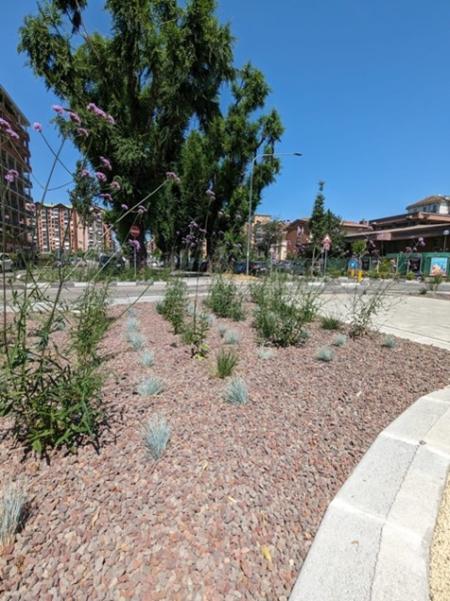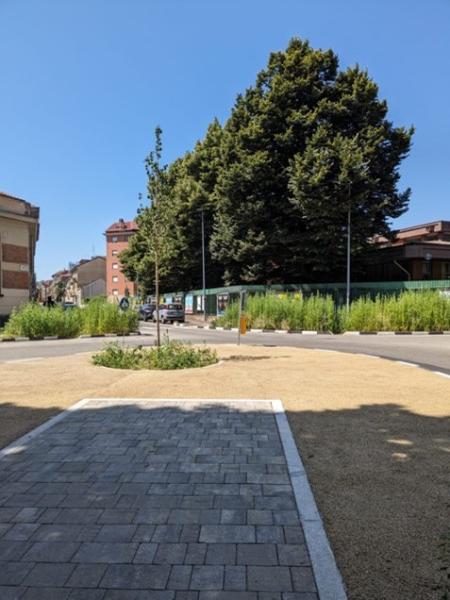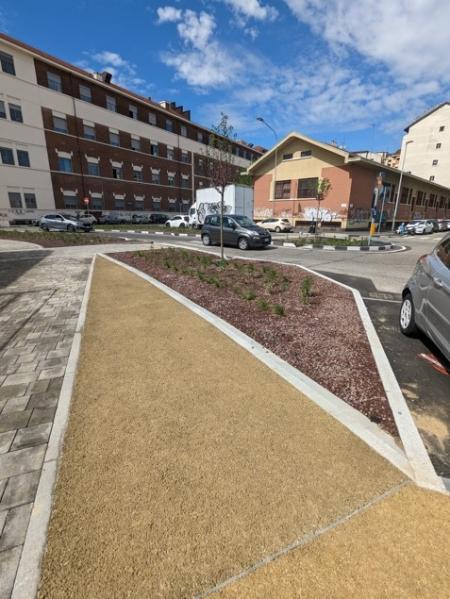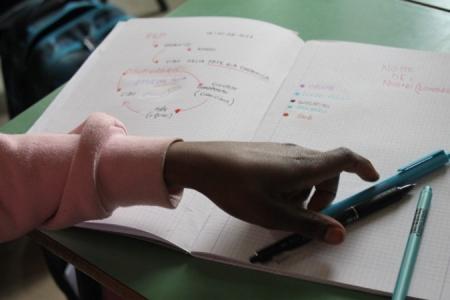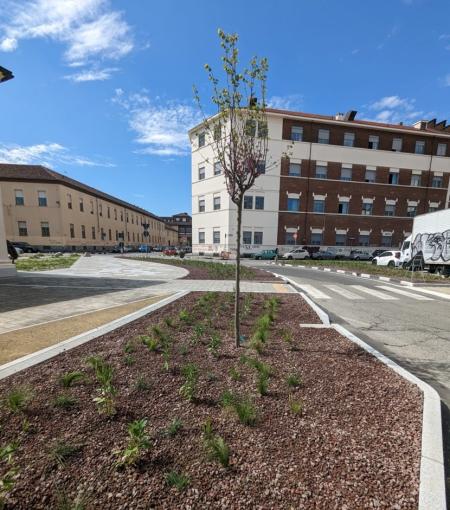
Area characterisation:
Within Borgo Aurora, Valdocco is a historic neighbourhood of the city of Turin in the 7th Municipal District. It is characterised by a highly dense built-up area, lack of greenery, and the predominance of car-centric public space, 90% of which is made up of vehicular roadways, road widenings, and traffic dividers that discourage community use. Proximity to the limited traffic zone (ZTL) of the city centre also causes high traffic and "parasitical" parking to avoid paid parking spaces. It is located near the river Dora Riparia, one of the main tributaries of river Po.
Valdocco’s settlement area bears witness to the city’s industrial manufacturing past and concentrates numerous services aimed at vulnerable social groups, including the Cottolengo hospital, the Opera Barolo social ecosystem, the Sermig Peace Arsenal, and various structures of the Salesian religious community.
The neighbourhood presents a highly diverse ethnic mix. In 2019, foreign residents represented 32.1% of the total population, with 36% of these coming from Romania, 33% from Morocco, 24.6% from China, and 6.4% from Peru.
As part of the Horizon 2020 CONEXUS project, the Life-Lab ‘Valdocco Vivibile’ (literally 'Liveable Valdocco') operates both at the micro-scale of Valdocco’s neighbourhood and at the larger metropolitan scale to develop scalable and replicable models for NbS implementation.
The Valdocco Vivibile Pilot tests the latest generation of design approaches that combine shading and stormwater management services integrated with attractive street furniture. The pilot has been designed for replication and informed the development of innovative materials and street furniture that best respond to the challenges related to climate change and density of the built environment in an urban context like that of Turin.
Objective:
The Valdocco Vivibile Life-Lab establishes a community of learning around urban NbS for ecosystem restoration, multifunctional ecosystem services, biodiversity enhancement, and social inclusion, promoting multi-stakeholder partnerships and collaborative leadership. It creates mechanisms for involving citizens, academia, and public, private, and third sectors at different governance scales through a powerful communication and dissemination strategy. A key element is the involvement of local schools and pupils in the co-creation of a public communication campaign to raise awareness of and build a shared knowledge on climate change and sustainability-related issues.
The Life-Lab’s main objectives are:
- To regenerate and repurpose public areas, moving away from car-centric development towards a people-centred, liveable urban model based on wellbeing-oriented mobility and inclusivity in line with the Torino 2030 Strategy;
- To test the latest generation of NbS design approaches tailored to Turin’s urban reality (historically-define streetscapes and architectural regulations) to address climate vulnerability;
- To foster collaborative planning and co-design processes, facilitating interactions and knowledge exchange with other cities within Conexus’ transnational partnership;
- To ensure long-term sustainability of NbS interventions and lasting political commitment.
Images
Financing:
- Horizon 2020 programme
- REACT-EU PON METRO
- Local incinerator compensation funds
Potential impacts/benefits:
- Increased climate resilience, counteracting heat islands and preventing flooding through better management of stormwater;
- Greening and pedestrianisation of public spaces, supporting sustainable mobility as well as recreational and social value of public green space while improving accessibility;
- Strengthened social inclusion and capacity through open participatory processes.
Actions:
The Valdocco Vivibile Pilot consists of small-scale green infrastructure interventions in a dense and consolidated urban tissue with the aim of transforming Valdocco into a climate-proof, liveable, and wellbeing-oriented neighbourhood (Climate Resilience Plan, 2020). Pilot interventions include:
- the reshaping of large crossroads where road curvatures are designed to channel cars into certain sections while creating rest/leisure areas for pedestrians, developed with permeable and green parts; these areas are also set up to collect rainwater from the streets, mitigating the outflow of water during intense rainfall;
- the construction of ‘muzzles’ in correspondence with minor crossroads for pedestrian crossings accompanied by green areas to collect rainwater;
- the extension of sidewalks in front of school complexes to create safe areas for students and parents;
- the clearing of paved areas and conversion into green infrastructure for shading and cooling;
- the installation of different types of urban green furniture to encourage opportunities for rest and socialisation in attractive green environments;
- the construction of shaded paths to encourage soft mobility and create pedestrian connection routes with other areas of the city;
- the use of materials able to reflect solar radiation and help reduce heat island effects;
- the installation of green roofs on public transport stops.
At the larger metropolitan scale, the ‘Life-Lab concept' is also tested as a methodology for locally delivering and valuing the strategies and policies defined in the city’s Climate Resilience Plan and Green Infrastructure Plan. Both strategic documents provide benchmarks to exchange practices and strategies integrating nature-based thinking (NBT) and solutions into urban development. Given the status of "test-site" conferred to Valdocco Vivibile by the Public Authority, its implementation assumes significant importance in the localisation of Turin’s new environmental policies.
Transferability of result:
The NbS interventions trialled in Valdocco have high replicability potential, both in terms of functionality and produced ecosystem services. Central elements of the pilot consist of promoting innovation around co-design approaches, materials used, selected vegetation, and new mobility patterns generated.
The Valdocco Vibile Pilot is part of a wider strategy of the City of Turin named ‘Resilient districts’. This strategy promotes innovative solutions to counter heat islands and better manage stormwater during intense precipitation events, increasingly frequent in urban centres, while creating a more liveable urban environment. Specifically, it intends to reduce asphalt and impermeable surfaces, promoting conversion into green infrastructure that can provide shade and collect rainwater, thus reducing flows into the grid and possible flooding.
Measures to reduce the velocity of motor vehicles allowing cars, bicycles, and pedestrians to coexist, i.e. roadway narrowings and chicanes, will also be implemented in other areas. The introduction of greenery and tree planting is envisioned as an additional design element for slowing traffic flows. As of today, these NbS have already been replicated in the San Donato neighbourhood, nearby Valdocco.
Lessons learnt:
- Establishing connections with other projects in the same area and similar projects in other areas of the city;
- Ensuring the long-term sustainability of the intervention (management and maintenance of green areas);
- Mainstreaming integrated and holistic planning and policies.
Organisations:
- Comune di Torino
- Torino Urban Lab
- Local primary and secondary schools
Contacts:
Valdocco Vivibile: Riccardo Saraco, Comune di Torino, riccardo.saraco@comune.torino.it
Urban Lab/Life-Lab: Alessandro Tempia Valente, Torino Urban Lab, alessandro.tempiavalenta@urbancenter.to.it
SDGs/NUA data: Federica Risi, EUKN, federica.risi@eukn.eu
Publications and reports:
The case study has also been produced in Italian
CONEXUS Deliverable 6.1 Report. Data on SDG/NUA impacts/potentials linked with investment propositions uploaded to Oppla.
Further information:
References
- CONEXUS Deliverable 3.1 Report with action plans for each Life-Lab (internal).
- CONEXUS Deliverable 2.2 Seven detailed EU and CELAC cases on NbS challenges and opportunities addressed: ‘Integration of NbS in local governance contexts and urbanisation trajectories in CONEXUS EU and CELAC cities. Evidence from Barcelona, Buenos, Aires, Bogotá, Lisbon, Santiago, São Paulo and Turin.’
- CONEXUS Deliverable 4.1 Assessment framework, indicators and participatory monitoring process.
- CONEXUS Deliverable 6.1 Report. Data on SDG/NUA impacts/potentials linked with investment propositions uploaded to Oppla.
- Turin Life-Lab CONEXUS Factsheet ‘Valdocco Vivibile: a livable district’, October 2023.
-
van der Jagt, A.P.N., Buijs, A., Dobbs, C. et al. (2023). An action framework for the participatory assessment of nature-based solutions in cities. Ambio 52, 54–67. https://doi.org/10.1007/s13280-022-01772-6.
-
Wild, T., Baptista, M., Wilker, J., et al. (2024). Valuation of urban nature-based solutions in Latin American and European cities. Urban Forestry & Urban Greening, Volume 91, 128162. https://doi.org/10.1016/j.ufug.2023.128162.
